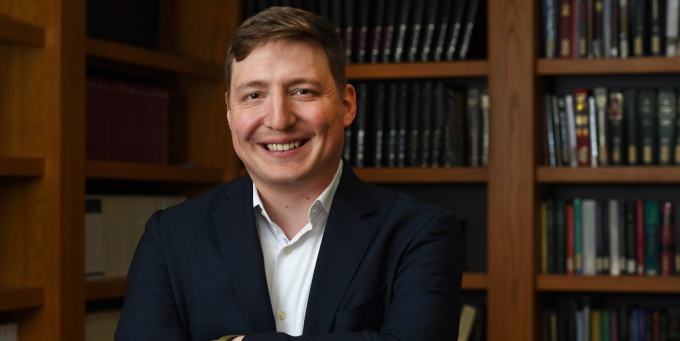
Taking the federal courts to task
The federal courts, points out Associate Professor John Harland Giammatteo, have a duty to enforce “fundamental federal rights against a large swath of state action.”
They’re falling down on the job, Giammatteo argues in a recently published law review article. In matters from the Americans With Disabilities Act to the Indian Child Welfare Act, from eviction proceedings to foster care determinations to criminal justice policies, he says, the lower-level federal courts have abstained from hearing claims challenging state court procedures.
Giammatteo’s article, “The New Comity Abstention,” published in the California Law Review, is drawing notice from his fellow scholars of civil procedure. The Association of American Law Schools has recognized it with two awards: Best Untenured Article, from the association’s Section on Federal Courts, and a Junior Scholarship Award Honorable Mention from the Section on Civil Procedure.
In the rapidly changing landscape of federal court procedure, the UB School of Law professor’s argument is part of a critical discussion. UB Law Links asked Giammatteo to elaborate on some of the implications of his influential article.
Your paper argues that the lower federal courts have nearly abdicated their traditional role in enforcing federal rights in their oversight of state courts. In what areas of civil procedure do you see that happening most?
There is a wide range, including challenges to bail procedures, the foster care system, and cases about public access to courthouses and proceedings under the First Amendment.
Some of these areas are challenges to state court adjudications which, as I discuss in the piece, is closer to the heartland of other abstention doctrines and federalism concerns. But many include challenges that implicate state courts’ institutional or policymaking roles. That includes places where the state courts are involved in the broader provision of social services, like foster care, or court policies like journalists’ access to the courthouse.
You call this trend “a new abstention doctrine,” which seems to imply a coordinated meeting of minds. Is that the case, or are judges arriving at this stance independently of each other?
I would not say the emerging abstention doctrine is a coordinated thing. It’s not like there’s a concerted or high-profile effort by an interest group, say, pushing for law reform or adoption of a particular legal argument. It is arising in an organic way, as precedent builds.
Which is part of what makes it so interesting and a helpful site to research federalism. And it does highlight some of the tensions inherent in a federal system—there are going to be places where institutions overlap and that can be perceived as friction. When that friction occurs, it’s often in the states’ interest in defending the lawsuits to raise abstention arguments. And federal courts may be tempted to look for escape hatches that avoid getting to the merits.
The federal courts’ recent turn toward conservatism and originalist constitutional interpretation has been well documented. Does that factor into the reluctance that you document?
There’s not a lot of originalism happening in these decisions. It is also not necessarily about ideology, either; judges appointed by multiple presidents and from both political parties have endorsed versions of the doctrine. And the same could be said for judges who have pushed back on broad abstention doctrines. The reluctance does, however, reflect a wider skepticism in the federal judiciary of the moment toward wielding its remedial authority and issuing structural injunctions, at least toward state actors.
That’s not to say there’s not an important history here. Two of the main Supreme Court opinions I talk about in the article—Younger v. Harris and O’Shea v. Littleton—are explicitly about backing away from the structural and institutional reform litigation of the Warren Court era and curtailing the federal courts’ remedial authority used in civil rights litigation.
Today, though, I think many federal judges are sensitive to federalism concerns and cautious about being perceived as undermining their state court colleagues. But I think it’s possible to balance those concerns and still fulfill their important role in vindicating federal rights and providing a federal forum for plaintiffs.
So what’s the solution? Can the state courts be trusted to hold the line against intrusions on fundamental constitutional rights?
As I argue in the piece, this is not necessarily about a skepticism toward state courts. In many circumstances, state courts are fully capable of enforcing rights and adjudicating fundamental constitutional claims. In others, state courts are behaving in good faith but might not be able to fully evaluate their policies in light of other constraints.
I would reframe the issue a bit. It’s about allowing those claiming rights to use the jurisdiction provided to them by federal statutes and the Constitution and allowing plaintiffs to choose the federal forum that they feel will allow their claims to be fully heard. That might not be the most efficient option, in that it requires federal courts to pass on issues the state courts might have thought they had resolved. But it allows for these claims to be fully heard and resolved.
For your students and for practicing attorneys, what are the implications of your findings on day-to-day practice?
One thing that I try to emphasize for my students is that one ignores civil procedure and federal courts doctrines at one’s own peril. That’s especially true in civil rights cases; plaintiffs must run a gauntlet of doctrines that can sink a lawsuit well before it gets to the merits. So lawyers need to be creative and precise as they think through their strategic choices. And abstention is one piece of that puzzle.